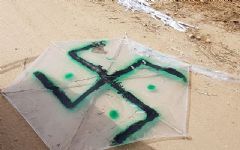Share
Human Rights Voices
While the UN devotes its human rights operations to the demonization of the democratic state of Israel above all others and condemns the United States more often than the vast majority of non-democracies around the world, the voices of real victims around the world must be heard.
Palestinian Authority/Gaza, April 20, 2018
Palestinians fly swastika kite with petrol bomb across Gaza border into Israel
Original source
Palestinians at the Gaza border flew a kite marked with a swastika and carrying a petrol bomb into Israel on Friday.
The Israeli army posted photographs of the kite in the air and on the ground inside Israel.
An IDF spokesman, Jonathan Conricus, wrote: "Moments ago, terrorist Hamas sent a Molotov cocktail over the Gaza border into Israel. They flew it with their true colors."
Friday marked the fourth weekend in succession that thousands of Palestinians have demonstrated at the border, in mass protests encouraged by the Gaza Strip's Hamas rulers. Originally declared as non-violent "March of Return" protests, the demonstrations are being encouraged by Hamas, which seeks to destroy Israel, and whose leaders say the goal of the protests is to erase the border and liberate Palestine.
The Israeli army says it has faced "terror" at the fence during the weekly protests, including a shooting incident, numerous efforts to breach the fence, stone- and bomb-throwing. In recent days, Gazans have flown kites carrying petrol bombs across the border, and these have caused fires several times in Israeli fields close to the border.
On Tuesday, one such kite started a fire in a grassy grove outside Kibbutz Be'eri, an Israeli community located some seven kilometers (4.3 miles) east of Gaza's Bureij refugee camp. It took four teams of firefighters to bring the blaze under control, a spokesman for the local fire department said. The Kan news broadcaster reported that the fire had spread over almost 100 dunams (25 acres).
The kites seem to be the latest phase in the ongoing clashes on the Gaza border, as Palestinians have rioted and protested along the security fence almost daily since March 30.
Fridays have been by far the most active days, with over 40,000 people taking part in the first protest, nearly 30,000 taking part in the second and approximately 10,000 participating in the third and most recent, according to the IDF's figures. As of late afternoon, Friday's fourth protests involved some 3,000 people.
These violent demonstrations have often included the burning of tires and Israeli flags.
Palestinian flags combined with swastika flags have also been sight.
As this month also marks the beginning of Israel's dry season, an IDF spokesperson on Friday said the military was prepared for the possibility that fires might break out and had therefore coordinated with local fire departments and put firefighting planes on standby.
However, when asked earlier this week specifically about the low-tech threat posed by kites carrying incendiary devices, the army offered scant details about its ability to combat the threat. "The IDF is prepared and ready for various scenarios during the riots organized along the Gaza fence," the army said in a statement.
On Monday, the local Eshkol regional council issued a stark warning to residents, telling them to be on alert for these airborne arson attacks.
"In the last 24 hours, there have been several cases of kites flying with Molotov cocktails from the Strip to our territory," the council said in a statement. "The public is asked to be alert and to report on any unusual incident of fires in the area."
Last month, the United Nations Relief and Works Agency (UNRWA) organized a "Kites of Hope" festival for over 1,000 Gazan schoolchildren from Khan Younis.
The National Forum for the March of Return, one of several Palestinian groups behind the weekly demonstrations, moved its protest tents closer to the border ahead of Friday's protests, in order, it said, to "affirm our right to return" - a reference to the Palestinian demand that Israel allow tens of thousands of refugees and their millions of descendants to return to their former homes inside Israel. Such a demand would mean the end of Israel as a majority Jewish state.
The protests in Gaza are expected to continue until mid-May, around the time the US is set to inaugurate its new embassy in Jerusalem.
Mid-May will also mark the anniversary of what Palestinians call the Nakba, or catastrophe, which saw hundreds of thousands of Palestinians flee their homes during Israel's 1948 War of Independence.
According to the United Nations, some 1.3 million of Gaza's 1.9 million residents are refugees or their descendants.
At previous peace talks, the Palestinians have always demanded, along with sovereignty in the West Bank, Gaza, East Jerusalem and the Old City, a "right of return" to Israel for Palestinian refugees who left or were forced out of Israel when it was established. The Palestinians demand this right not only for those of the hundreds of thousands of refugees who are still alive - a figure estimated in the low tens of thousands - but also for their descendants, who number in the millions.
No Israeli government would ever be likely to accept this demand, since it would spell the end of Israel as a Jewish-majority state. Israel's position is that Palestinian refugees and their descendants would become citizens of a Palestinian state at the culmination of the peace process, just as Jews who fled or were forced out of Middle Eastern countries by hostile governments became citizens of Israel.

